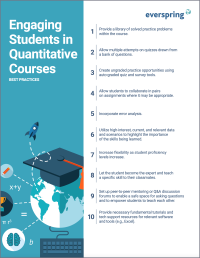Search
There are 7 results.
Tag
Tag
All (156)
Active Learning (4)
Activities (5)
Alt Text (1)
Analytics (4)
Annotated Bibliography (1)
Assessments (15)
Asynchrony (5)
Authentic Activities (3)
Backwards Design (2)
Belonging (3)
Canvas (10)
Case Studies (2)
Collaboration (7)
Color Contrast (1)
Communication (11)
Community (9)
Competency-Based Education (5)
Content Creation (32)
Copyright (2)
Course Maintenance (6)
Course Materials (15)
Course Preparation (12)
Discussions (5)
Diversity (4)
Equity (2)
Faculty Presence (9)
Faculty Support (5)
Feedback (11)
Formative Assessments (9)
Game-Based Learning (2)
Gamification (1)
Generative AI (9)
Grading (8)
Group Work (2)
Images (4)
Inclusion (8)
Infographics (2)
Learning Objectives (4)
Multimodality (7)
Page Design (2)
Peer Review (1)
PowerPoint (2)
Presentations (3)
Qualitative courses (1)
Quantitative courses (1)
Representation (2)
Revising (2)
Revision (1)
Rubrics (4)
Scaffolding (1)
Screen Readers (1)
Social Media (2)
Summative Assessments (1)
Synchrony (7)
Third-Party Tools (2)
Universal Design for Learning (UDL) (4)
Video (13)
Visual Accessibility (2)
Visual Design (2)
Workforce Development (1)
Workload (1)
Written Assignments (1)
Harnessing the Third Space Theory for Effective Learning and Instructional Design Consultation
The Third Space theory, introduced by postcolonial theorist Homi K. Bhabha, explores a transformative space where new identities and meanings emerge through the interaction of diverse cultural elements. This "third space" is characterized by hybridity, challenging rigid, binary notions of identity and culture, and emphasizing fluid negotiations between dominant and marginalized perspectives (Burke, 2012; Lin, 2014). Bhabha’s theory builds on Ray Oldenburg’s (1999) concept of the "third place"—an informal public space where people gather to form a community that is neither home nor work—and extends it into the realms of cultural and social discourse, creating a broader framework for negotiating power, identity, and cultural exchange (Bhabha, 2012). These third spaces can emerge in a variety of contexts, including both physical locations like cafés or parks and virtual environments such as online forums or social media platforms, making the theory applicable to both in-person and digital interactions.
Communication, Community, and Student Engagement in the Online Classroom
The most difficult task in transitioning from on-ground to online teaching is determining the best way to emulate the community and engagement inherent in a face-to-face classroom.Consider this: Your online classroom can be even more engaging than an on-campus classroom. Simple tools, such as discussion forums and announcements, can elevate your classroom immensely.
Building Your Online Course With the Lister Model
You are building a course for the online environment. What an exciting adventure! When building an online course, you might use a similar method to what you used when developing a course previously, or you might use an entirely new technique. Either option is a good option. But you may have a few questions when you first begin: How do I organize my materials? How do I display my materials? How do I make sure my students work together?







